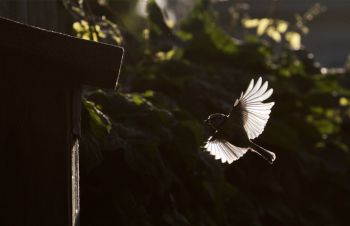
© Chris Sandom
Organisers are urging people to continue to take part in the City Nature Challenge and find ways to connect with nature from their home.
This year, the Brighton & Lewes Downs Biosphere (The Living Coast) joined the national challenge for the first time, thanks to efforts from University of Sussex staff and students.
Taking place between 24 and 27 April 2020, it aims to connect people with local nature by discovering and recording as much wildlife as possible over the four day period.
As a flagship event of Nature 2020, people will be asked to document their local biodiversity to the best of their ability within new public safety parameters.
Dr Chris Sandom, Senior Lecturer in Biology at the University of Sussex, said: "During such uncertain times, it's more important than ever to foster a sense of community, and the City Nature Challenge allows participants to do just that. For both budding and veteran citizen scientists, participating is easy; look for any wild plant, animal, fungi, slime mould, or any other evidence of life (scat, fur, tracks, shells, carcasses!) found in your home, garden, or even through your windows. You might be surprised by how many insects thrive in the nooks and crannies around you."
Staff and students at both the University of Sussex and the University of Brighton who are part of the local organising team, are encouraging people to take part and embrace the collaborative aspect of sharing observations online with a digital community, while safely celebrating the healing power of nature, adhering to social distancing measures.
Dean Cooney, Conservation Biology Masters student, said: "We are really pleased to be bringing the City Nature Challenge to The Living Coast, providing something fun that the family can get involved in while staying at home. If you have a garden, balcony or any outdoor space, you can bring wildlife to you by putting up moth lights or putting down cover boards and seeing what's under them in the morning. There are a range of ideas available to look at online."
Using the free iNaturalist App, people within the Biosphere region can take photos of any wildlife discovered. The app will then count the number of observations, species identified, and observers who take part to measure how successful each region has been.
Sarah Dobson, The Living Coast Biosphere Programme Manager, said: "The event targets people living in both rural and urban areas. As well as in the countryside, nature exists in every city, and one of the best ways to study it is by connecting scientists and the community through citizen science. As global human populations become increasingly concentrated in cities, it's more important than ever to document urban biodiversity and help ensure the future of our wildlife."
Self-isolating individuals and groups are encouraged to either log sightings from their home (between 24 and 27 April) or to identify species (between 24 April and 3 May). Others are encouraged to take part from their own home or by keeping alert during their daily exercise allowance. Findings will be announced on 4 May.
It is imperative that participants closely follow government and local public health guidelines as they are updated in real-time in response to COVID-19. For detailed information about how the City Nature Challenge is adapting to COVID-19, visit citynaturechallenge.org/COVID19.






